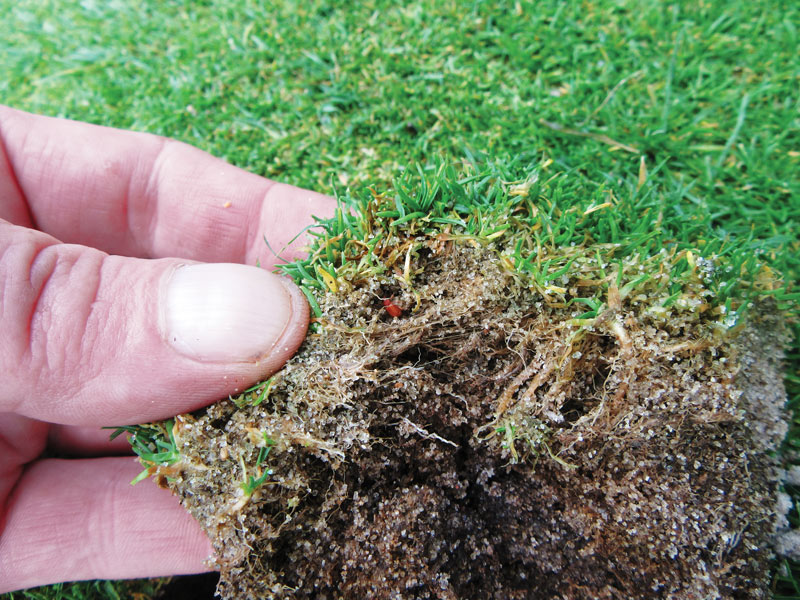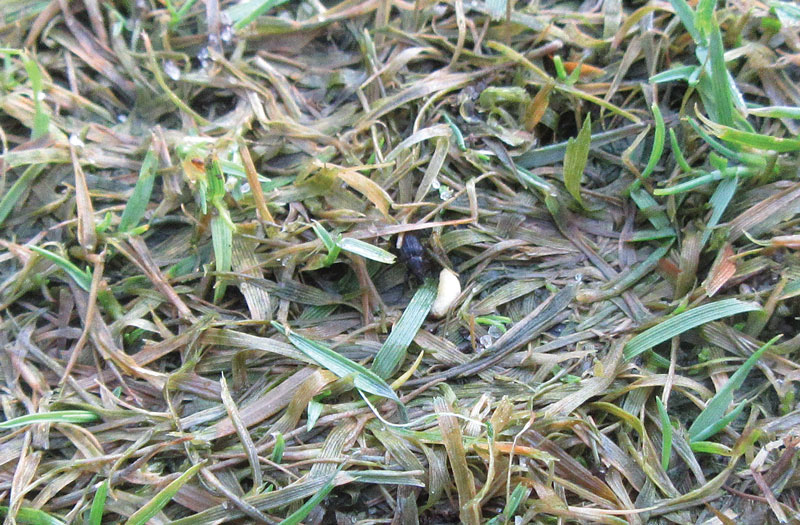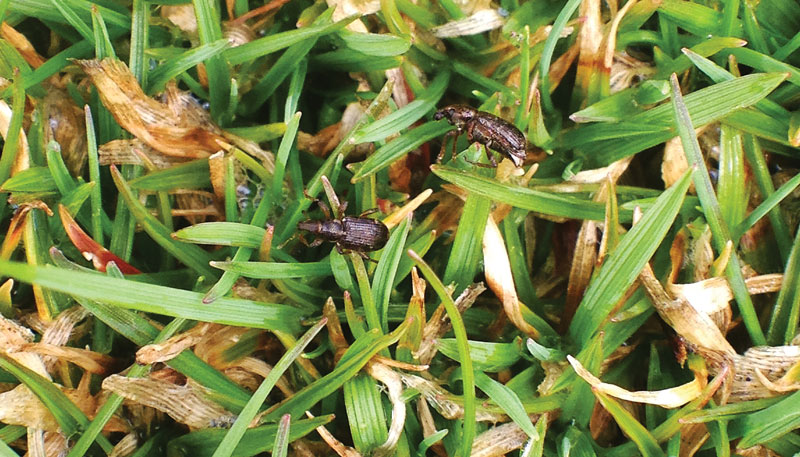
Turf insects reside in or lay their eggs in the soil, and their larvae or grubs feed under the surface or in plant crowns and stems, all of which makes locating them difficult. Photo by Steve McDonald
When British rock band Dire Straits released the song “The Bug” in 1991, it’s probably safe to say they weren’t referencing turfgrass entomology. However, the song’s lyrics — “Sometimes you’re the windshield, sometimes you’re the bug”— could aptly describe how easy it is to upset the delicate balance that a wide variety of insects bring to a golf course. And if you’ve ever been cast in the role of “the bug” in your career, you know there is really no desire to experience that event again. Ever.
So, creating a plan that reduces the impact of turf insects on the playing surface by incorporating such principles as pest identification and monitoring, action thresholds, and methods of control is a sound strategy — one that can ultimately help you avoid hitting the proverbial “windshield.” (See our turfgrass insect management strategies chart for a handy, insect-specific breakdown.)
First, the foundation
If you’ve ever built a structure as part of a construction project, you know how vital the foundation is to the support and durability of that structure. A poorly laid foundation affects each component it supports, including walls, doors, windows and even the roof. The same concept applies to creating an agronomic insect control program.
The foundation and success of the program hinges on strong and healthy turfgrass, which is the result of properly applied cultural practices. Mowing, fertilization and irrigation all contribute to the density, health and vigor of the turfgrass stand. The healthier the stand, the better the turf will withstand the biotic and abiotic stresses that invariably appear throughout the season.
This also relates to turf recovery should insect damage or other in-season stresses occur. A poor stand of turf will not withstand minor insect infestations, respond to insect control applications or recover well from insect damage, so cultivating healthy turf is a crucial component of building your agronomic program.
The key is to find a balance between excessive and insufficient inputs. For example, too much fertility creates lush growth and increases organic matter and thatch depth, which then attracts insects such as chinch bugs, billbugs or sod webworms. Excessive irrigation creates moist soils that attract many adult beetles of white grubs searching for locations to lay their eggs, which will ultimately become destructive white grubs. However, on the flip side, low fertility and low irrigation that might deter insects from the area can also cause poor turf quality. Identifying and understanding the requirements for each turfgrass species you are managing is critical to planning and implementing a comprehensive program.
Site assessment and monitoring
Unlike some turfgrass diseases whose symptoms are exhibited on the surface of the turf, turf insects can be challenging to find. They reside or lay their eggs in the soil, and their larvae or grubs feed under the surface or in plant crowns and stems. Adult insects are mobile and escape or hide deep in the turf canopy. Fortunately, most turf insects have preferences for certain species of turf, and these preferences offer clues about where and in what time of the season to find them when carrying out scouting and mapping tasks.
If there is a history of the type of insect that is damaging certain areas of the course, it may be beneficial to record and refer to this information when forming a plan of action for the following year. For example, annual bluegrass weevil, as the name implies, feeds primarily on annual bluegrass. The adults are active in spring and move out of tree-lined areas into fairways, tees, collars and green surrounds that contain annual bluegrass. These are the areas to scout first. Keep track of any insect activity that may be occurring either through visual observations or by using pitfall traps designed to capture and monitor adult movements.
Another example is the European crane fly. This insect prefers cool-season turfgrasses that have excessive thatch with high organic matter and moist soils. Damage from the larvae, called leatherjackets, can occur in fall after egg hatch and also in spring before pupation. In some instances, soap flushes — a practice that brings the soil- or canopy-dwelling insect to the surface — are an excellent way to monitor both population density and the current life stage or stages that are present and may be causing the damage. Coupling pest history and location enables targeted insect monitoring to be performed in hot spots and indicator areas to predict further pest outbreaks on the course and provide valuable data for future treatment decisions.
Turfgrass insects: Know the cycle
While knowing what to look for when scouting and mapping areas of the course for insect frequency is essential, understanding the life cycle of the insect is just as important, especially if cultural control methods aren’t enough.

Severe damage to bentgrass with larva and adult in center. Preventive or early applications of insecticides for grub control can protect turf from extensive damage. Photo by Steve McDonald
The best way to make an insecticide treatment work its hardest for you is to target the most susceptible stage of the insect. For example, Japanese beetle grubs generally hatch in mid- to late summer and are small and very susceptible to many white grub insecticides. Applications that target this timing are much more effective than those focused on the late-instar larvae, which are nearly mature and have cut back on feeding because pupation to an adult is imminent.
Bluegrass billbugs provide another example of the importance of application timing. Although billbug larvae do not damage turf early in the year, the adults emerge early in spring, mate and lay their eggs. After those eggs hatch in early to midsummer, the larvae burrow into the stems and crown of the plant. Once inside the plant, the insects are protected and won’t be visible or reachable with an insecticide, so control becomes quite difficult. Preventive treatments that protect plants from larval feeding early in spring, before egg hatch, are thus crucial for effective control. Understanding such key timing details will make a significant difference in the level of control received from an insecticide application.
To treat or not to treat
Many times, discovering the actual presence of a damaging insect while scouting isn’t a green light for action beyond cultural practices to enhance the health of the turf. One mole cricket adult on a golf course fairway is likely tolerable, but one mole cricket adult on a small par-3 putting green is not.
Damage thresholds are typically a general rule based on the degree of damage that is acceptable before other actions need to be taken. That being said, action thresholds will vary widely from one course to another, and even locations within a course will be weighted differently. The level of tolerance or threshold levels for each area of the golf course will play a major role in determining what actions, if any, should be carried out under an insect control program.
Let’s imagine for a moment that we’ve been monitoring and scouting for southern chinch bugs in St. Augustinegrass for the last few weeks. Up to this point, visual observations and flotation sampling (a method of using water to float the insect to the surface using a cylindrical, open-ended container pushed into the soil) have yielded no hits. However, today’s sampling floated small red and older nymphs to the surface in significant numbers. Now what? A treatment is warranted, but which product is the best?
A well-thought-out program will help eliminate those types of panic questions by taking into account such scenarios ahead of time, so that after a threshold has been exceeded and the decision is made to treat, that action can occur immediately. To reach this point, however, it’s imperative to understand what differences exist among products that might be labeled for the same pest (some pyrethroids are labeled for grub control even though they bind tightly to the soil and rarely reach the grubs to impart control), and, more specifically, how they do or do not move in the plant.
Insecticides that are absorbed into plant tissues and then move within the vascular system of the plant are generally referred to as systemic. This mode of activity is important for root-feeding, soil-dwelling pests as well as for those that feed inside the stems and crown of the plant, because the insecticide can protect from the inside out. Systemic products typically require a period of time to be absorbed into the plant and therefore perform well as preventive applications before pest activity is present. They also tend to have extended residual control that may last as long as several months.
The opposite of systemic activity is contact activity. This group of products does not typically penetrate the plant tissue and stays on the surface, where the insect is exposed to the active ingredient. Contacts are effective for protecting the outside surface of the plant, either as a preventive barrier or, in some cases, after aboveground plant feeding has already begun. Contact insecticides tend to have a quicker mode of activity on the target insect, but also have shorter residual compared with systemic insecticides.
These simple delineations can assist turfgrass managers in choosing the correct product for the scenario in question. In the case of the chinch bug situation described above, a contact such as a pyrethroid (lambda-cyhalothrin, bifenthrin, etc.) was the product of choice, because the population was small and sensitive to pyrethroids (more on resistance later), and a spot treatment of the localized area was all that was necessary to stop the bugs from becoming a large-scale problem. Spot treatments can be effective at times, but preventive applications of systemic insecticides such as neonicotinoids (thiamethoxam, imidacloprid, etc.) or diamides (chlorantraniliprole, cyantraniliprole, etc.) to areas with known histories of insect occurrence can be the most effective method of thwarting widespread damage.
Two for one
Consideration of the insect spectrum of a treatment is also important. Today’s insecticides are typically active against more than one insect and can provide, at a minimum, a dual benefit within a designed program.
Take, for example, Acelepryn insecticide (active ingredient chlorantraniliprole, Syngenta), an effective preventive treatment for white grubs. The application for white grubs will also provide multiple weeks of control of cutworms, armyworms and sod webworms that cause damage throughout the season.
Consider which key insect pest(s) to target, and then compare product labels to determine what additional spectrum of insects will be controlled. The other consideration is the lack of activity of that treatment on desirable insects that inhabit the golf course ecosystem. Acelepryn is also a good example of how turf maintenance practices and preservation of beneficial/non-target organisms, including pollinators, can coexist.
Turfgrass insecticide resistance management
A final aspect that is relatively easy to record after an agronomic plan for insect control is in place is the rotation of insecticides with different modes of action. Although most insecticides are efficacious against the target insect, repeated use year after year can lead to the selection of insects that may not be as sensitive to that active ingredient or may even become resistant over time.

Because annual bluegrass weevil is a recurring pest and has for years been exposed to multiple high-rate insecticide applications in the Mid-Atlantic region, insecticide resistance has become a problem in the area. Photo courtesy of Sam Camuso
Fortunately, insecticide resistance in turfgrass pests is relatively limited, especially among insects with annual life cycles, because fewer are exposed to a specific mode of action in a season. Insect pests that have multiple generations in a season have a higher risk of naturally selecting less-sensitive individuals from the population. Examples include chinch bugs in areas of Florida and annual bluegrass weevil adults in the Mid-Atlantic region, which both have become resistant to pyrethroids after multiple high-rate applications for multiple years. Rotating insecticides with different modes of action can delay resistance while still controlling the current population and preserving control options for future programs.
Keeping it fluid
Once there’s an understanding of the target pest, its life cycle, injury tolerance and available treatment options, the program is ready to be implemented. Mapping and scouting histories will give the turfgrass manager clues about where and when to scout for the pest. Insect life stages provide information about when to target applications. Establishing a plan for implementation is just as critical as the program itself. A number of indicators can be used to determine when treatments should be applied to control or prevent insect infestations: turf response; growing degree day thresholds (numerous GDD calculators are available online; see “Growing degree day tools,” below, for a list of some); plant phenological indicators such as forsythia bloom; sampling population numbers; or a combination of factors. No matter which indicator signals action should be taken, proper planning and communication are essential to initiating the program in a timely manner. For recurring pests such as annual bluegrass weevil or mole crickets, it’s important to evaluate all facets of an insect control program to improve and adjust the program throughout the season and in subsequent years.
Assessing how well the program worked at the end of the infestation or season can provide a valuable opportunity for making adjustments to product selection and timing and even re-establishing damage thresholds. Additionally, a program approach should also account for time and money required and then be discussed with committee and/or board members. These elements are useful in determining what changes, if any, should be made before the next period of insect activity.
Final considerations
Although every insect pest may not need a specific agronomic program, superintendents will certainly find it worthwhile to build a foundation of healthy turf, to have documented past pest occurrences to help simplify time of application, and to know the most effective practices and products. Understanding insect life cycles and targeting development stages that are most susceptible with the appropriate insecticide mode of activity and mode of action are paramount to any program’s success.
Armed with this information, a superintendent can customize a plan of action for the golf course that is achievable and certainly increases the likelihood of a successful outcome. Had Dire Straits in fact been thinking about turfgrass insects, a considerably less catchy but more fitting lyric might have been, “It’s good to be the windshield; try not to be the bug.”
Growing degree day tools
References
- Brandenburg, R.L., and C.P. Freeman, eds. 2012. Handbook of Turfgrass Insects. 2nd ed. Entomological Society of America, Lanham, Md.
- Potter, D.A. 1998. Destructive Turfgrass Insects: Biology, Diagnosis, and Control. Ann Arbor Press, Chelsea, Mich.
- United States Environmental Protection Agency. 2017. Introduction to Integrated Pest Management. www.epa.gov/managing-pests-schools/introduction-integrated-pest-management
Matt Giese, M.S., is the Midwest field technical manager for turf and landscape at Syngenta and a 24-year veteran of the turfgrass industry.